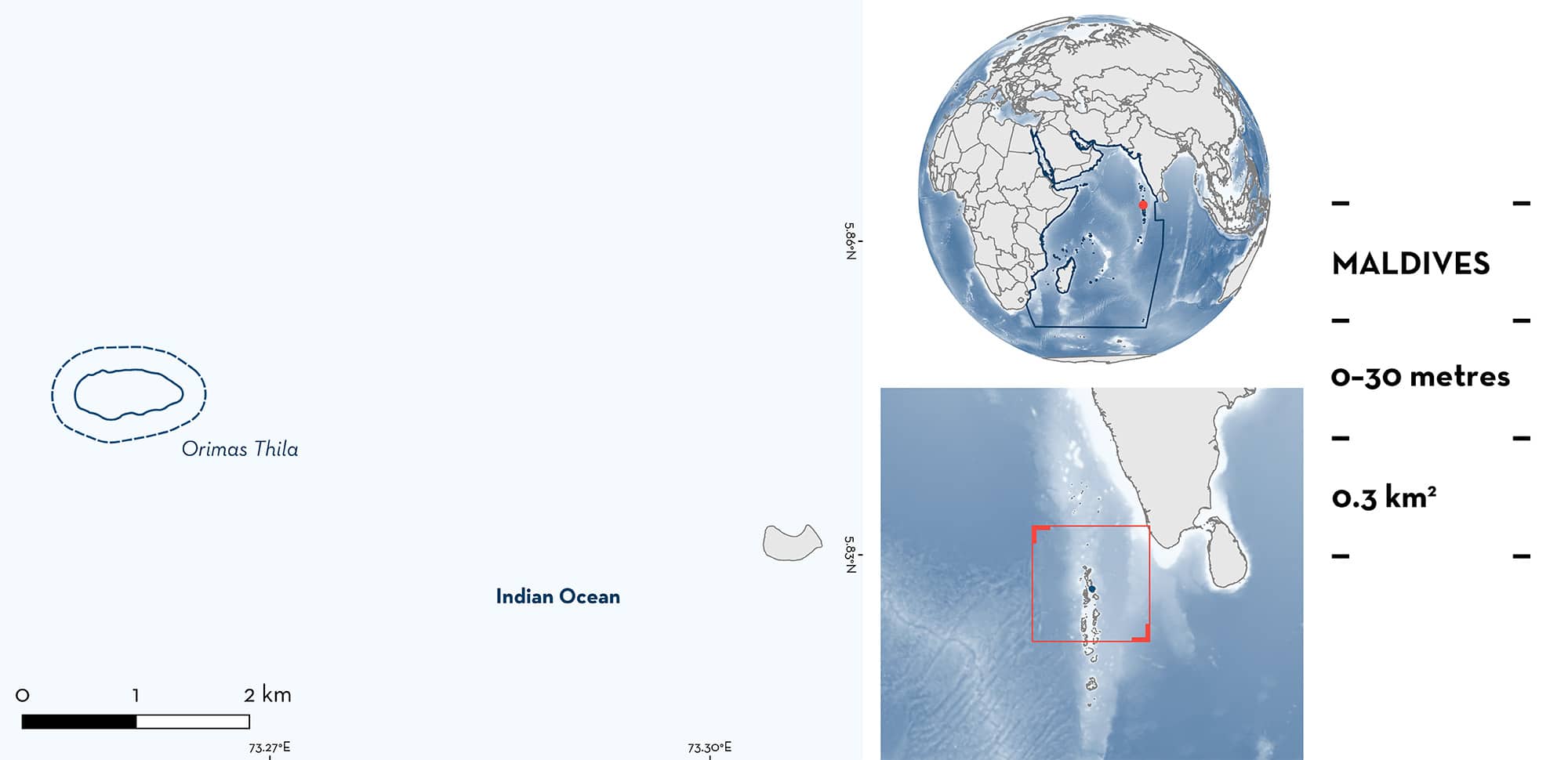ISRA FACTSHEETS
ISRA FACTSHEETS
WESTERN INDIAN OCEAN REGION
Orimas Thila
Summary
Orimas Thila is located in the central waters of Noonu Atoll within the Southern Miladhunmadulu Atoll of the northern Maldives. This area is an underwater pinnacle reef with a completely submerged top, even during low tide. The top of the reef starts at 14 m depth and the reef edge drops to 30 m. This area overlaps with Orimas Thila marine protected area. Within this area there are: threatened species and undefined aggregations (Grey Reef Shark Carcharhinus amblyrhynchos).
Download factsheet
Orimas Thila
DESCRIPTION OF HABITAT
Orimas Thila is located in the northern Maldives archipelago which sits centrally upon the Chagos-Laccadive Ridge (Stevens & Froman 2019). Specifically, this area is situated in the central waters of Noonu Atoll, within the Southern Miladhunmadulu Atoll. Thila is a local name that refers to an underwater pinnacle reef, where the top is completely submerged even during low tide (Godfrey 2018). The top of the reef starts at 14 m depth and the reef edge drops to 30 m.
The weather in the Maldives is strongly influenced by the South Asian monsoon, especially the northern and central atolls as these are closer to the Indian subcontinent (Anderson et al. 2011). Two monsoons occur annually in Maldives: the southwest monsoon (May–November), and the northeast monsoon (January–March), with transitional periods in December and April (Shankar et al. 2002; Anderson et al. 2011). The Maldives archipelago disrupts the flow of the monsoon-driven North Equatorial Current as it crosses the Indian Ocean (Schott & McCreary 2001) which creates a current flow through the Maldives’ channels (Sasamal 2006).
This area overlaps with a marine protected area also called Orimas Thila.
This Important Shark and Ray Area is benthopelagic and is delineated from surface waters (0 m) to 30 m based on the depth range of Qualifying Species in this area.
CRITERION A
VULNERABILITY
The one Qualifying Species within the area is considered threatened with extinction according to the IUCN Red List of Threatened SpeciesTM. The Grey Reef Shark is assessed as Endangered (Simpfendorfer et al. 2020).
CRITERION C
SUB-CRITERION C5 – UNDEFINED AGGREGATIONS
Orimas Thila is an important area for undefined aggregations of one shark species.
Data were collected from a citizen-science program known as the Sharkwatch project which was a government-led initiative between 2009–2019 (Maldives Marine Research Institute [MMRI] unpubl. data 2023). Data were recorded by experienced dive guides using the roving diver technique where surveyors can swim in any direction and count the number of individuals encountered by species during one-hour dive surveys. From the ~1,110 sites surveyed in the Maldives, this area has been identified as one of the most important aggregations of Grey Reef Shark (MMRI unpubl. data 2023).
Sharkwatch surveys were conducted in this area over nine years (2009–2017; n = 40) (MMRI unpubl. data 2023). Grey Reef Shark were the most abundant species with a mean encounter rate of eight sharks/hour and a maximum of 50 sharks/hour aggregating at this area (MMRI unpubl. data 2023). The highest encounters for Grey Reef Shark were recorded in 2009, 2011, and 2014 with 50, 30, and 28 sharks/hour, respectively (MMRI unpubl. data 2023). Sharks have been observed with records of >25 sharks/hour in a single survey in both monsoon seasons (MMRI unpubl. data 2023). Further information is needed to understand the nature and function of these aggregations.
Download factsheet
SUBMIT A REQUEST
ISRA SPATIAL LAYER REQUEST
To make a request to download the ISRA Layer in either a GIS compatible Shapefile (.shp) or Google Earth compatible Keyhole Markup Language Zipped file (.kmz) please complete the following form. We will review your request and send the download details to you. We will endeavor to send you the requested files as soon as we can. However, please note that this is not an automated process, and before requests are responded to, they undergo internal review and authorization. As such, requests normally take 5–10 working days to process.
Should you have questions about the data or process, please do not hesitate to contact us.


